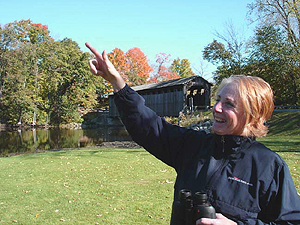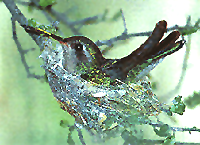Welcome to my hummingbird tips and information site. 
On this site you will find information on hummingbird feeder care, tips for attracting Hummingbirds to your yard, great tips on preventing bees and ants at your hummingbird feeders, and my recipe for preparing Hummingbird nectar that your hummingbirds will truly love. In addition, you will find a great selection of hummingbird feeders with the best prices on the Internet.
Nectar Recipe
I have found that this is the best recipe for making your own nectar--I feel the birds prefer it over the various instant mixes.
- 1 Part Sugar (part = your measuring container)
- 4 Parts Cold Water
- Dissolve the sugar either by shaking in a bottle or warming on the stove (It does not need to be boiled)
- Store In Refrigerator for up to 2 weeks
- Change the nectar in the feeder every 2-3 days
Never use honey or artificial sweeteners! Honey ferments easily, and can cause sores in a hummers mouth. Artificial sweeteners have no food value. DO NOT use red food coloring in your solution, as this could be harmful to your hummers. No testing has been done on the effects dye has on birds.
What To Do About Ants
The best way to prevent ants at your feeder is to use an "ant guard". An ant guard is a barrier between the ants and the nectar. These guards are built into many feeders but are also available as an add-on accessory for existing feeders.
Back to top of page
What To Do About Bees
Hummingbird feeders come in many shapes, styles and designs. Some are very good at preventing bees and some would be better labeled as bee feeders. The thing to remember is that bees and wasps compete for nectar at flowers and feeders yet both seem to survive.
To stop attracting bees to your feeder you need to prevent the bees from reaching the nectar. Feeders by Best 1, Aspects or Droll Yankee are the best at keeping nectar out of the reach of bees. Even with bee proof feeders a little extra care is needed as when hummingbirds eat they lap, not suck up the nectar. This lapping causes a small amount of nectar to end up on the surface of the feeder near the feeder ports which the bees will quickly find. When you see bees on a bee proof feeder, simply wipe the surface with a wet sponge and your bees will leave.
Feeder Care
Your hummingbird feeders need to be cleaned, and nectar changed every 3-4 days--more often in hotter weather. If you see black spots inside your feeder this is mold and you will need to scrub it out with a good bottle brush, but if you can't reach it with a bottle brush you can add some sand with water and shake the feeder to remove the mold. You should never use harsh detergent to clean your feeder. Rinse out each time you change your nectar with hot water, and if you do this on a regular basis you should not have a problem with mold inside the feeder. Don't fill the feeder more than half full, because they won't be able to drink it all before it will need to be changed.
Successful Tips for Attracting Hummers to Your Yard!
If you never seem to be able to attract hummingbirds to your yard, try one or more of these tips, and you should see hummers at your feeder soon! All hummingbird feeders that are purchased these days have red on them somewhere,but if you are in doubt that there is enough red, try tying a red ribbon on the feeder. Another way to attract attention to your feeder is to place it among flowers that hummers like, or hang a basket of flowers nearby. You will find that feeder activity slows as more flowers bloom in your yard. Do not panic! They prefer natural nectar over what we give them in our feeders, so they are still around, and you will see them at your feeders more often, as the blooms start to diminish. If you live in the Eastern part of the United States, you will find you only have one hummingbird that will visit us for the summer, and that is the Ruby-throated. They are very territorial and defend flowers and feeders within their favorite roost spot, so if you want to attract more than one hummer, try putting up 2-3 more feeders out of sight from each other--perhaps on another side of your house.
Flowers, Shrubs, Vines and Trees That Will Attract Hummingbirds
The following is a list of flowers, shrubs, vines, and trees that hummingbirds are attracted to. Note: none of these need to be red in color, although the color red is attractive to hummingbirds. If in doubt as to whether any of the following will flourish in your area, please check with your local nursery.
Cardinal Flower Lobelia cardinalis
Lantana Lantana camara
Columbine Aguilegia spp.
Fuchsias Fuchsia spp.
Impatiens Impatiens spp.
Coral-Bells Heuchera sanguinea
Hollyhocks Althea spp.
Penstemen Penstemen spp.
Petunia Petunia spp.
Flowering Tobacco Nicotania alata
Geranium Pelargonium spp.
Begonia Begonia spp.
Shrubs
Azaleas Rhododendron spp.
Butterfly Bush Buddleia davidii
Flowering Quince Chaenomeles japonica
Honeysuckle Lonicera spp.
Weigela Weigela spp.
Trees
Flowering Crab Malus spp.
Tulip Poplar Liriodendron Tulipifera
Locust Robinia
Eucalyptus Eucalyptus spp.
Vines Honeysuckle Lonicera heckrottii
Morning Glory Ipomea ssp.
Trumpet Creeper Campsis radicans
Trumpet Honeysuckle Lonicera sempervirens
When To Put Up A Feeder
Most Hummingbirds are migrant, and visit North America in the warmer seasons. Feeders should be put up in time for their arrival. This will vary greatly depending upon where you are located. In the Florida area they arrive as early as January, and in the Upper Great Lakes they arrive mid-April to mid-May. It is important to know the average date they arrive in your specific area to get your feeder up 5-10 days before the average date so they will see your feeder up and take a drink, and possibly stay for the season in your backyard!
When To Take Feeders Down
We have found one of the biggest misconceptions about hummingbirds is the belief that if you do not take your hummingbird feeder down they will not migrate. This is absolutely false! In many areas hummingbirds start to migrate even before the flowers and insects start to wane. Males generally migrate several weeks ahead of immatures (new hatchlings) and females. Migration is done according to changing day length or photoperiod. Actually, migrating hummingbirds may be helped by feeders that are left up until at least two weeks have passed since seeing your last hummer.
Back to top of page
Amazing Myths and Facts
Myth: Hummingbirds migrate on the backs of geese.
Fact: NO! Hummingbirds and Canada Geese migrate at different times, live in different habitats, and migrate to different areas.
Myth: Hummingbirds suck nectar.
Fact: Hummingbirds do not suck nectar. They place their open bill into the feeder and lick up the nectar at a high rate of speed.
Myth: Hummingbirds eat from only red flowers.
Fact: Yes, hummingbirds are attracted to red, but you need only to observe them for a short period to realize that they will eat from any color of nectar-producing flowers.
Back to top of page

Most of the above information can be found in The Hummingbird Book by Donald and Lillian Stokes. Published by Little, Brown and Company. (ISBN 0-316-81715-5)
